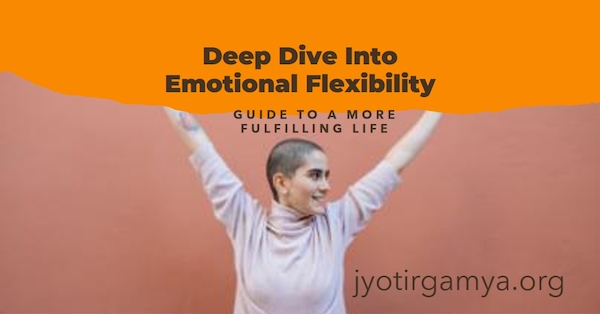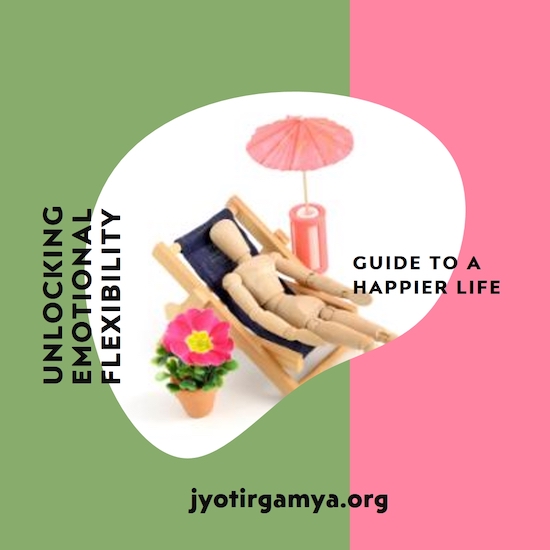Deep Dive into Emotional Flexibility: Guide to a More Fulfilling Life
Here’s a simple analogy: imagine you’re driving down the road, and you see a red light. You stop at the light and wait for it to turn green. While you’re waiting, you feel a little impatient, but you know you must wait for the light to turn green before you can go. Once the light turns green, you start driving again.

This is an example of emotional flexibility. While waiting at the red light, you managed your impatience and waited for the light to turn green. Once the light turned green, you could shift your emotions to excitement and anticipation.
Emotionally flexible people can do this in all kinds of situations. They can experience complex emotions like sadness, anger, and anxiety, but they don’t get stuck in those emotions. They’re able to move on and experience other emotions, both positive and negative.
You’re experiencing a difficult time in your life, such as a job loss or a death in the family. You feel sad, angry, and anxious. You allow yourself to feel these emotions but don’t dwell on them. You also seek support from friends, family, or a therapist. You also focus on taking care of yourself physically and emotionally.
Emotional flexibility is like having a toolkit of emotions and knowing when to use each in different situations. It’s about switching your feelings to match what’s happening around you.
For instance, you can feel empathy and support if someone is sad. But if you’re playing a game and lose, you can switch to feeling determined to do better next time.
It’s all about adapting your emotions to fit the moment, just like a teacher in a classroom who can be caring, patient, or firm as needed to help their students.
This guide isn’t about forcing happy thoughts. It’s about learning to bend, not break, when life throws curveballs.

Feeling Stuck? Check for Emotional Rigidity Like a Detective!
Imagine life as a flowing river, constantly changing and adapting. But what if you felt stuck on a rock in the middle, unable to move with the current? That’s what emotional rigidity can feel like – being inflexible and stuck in your emotions. Let’s be detectives and uncover the signs:
Spotting the Clues of Emotional Inflexibility
Ever feel like you’re always right or get super angry over little things? These could be clues of emotional rigidity:
-
Always on Repeat: Do you hold onto grudges forever, replaying negative thoughts like a stuck record? This can make it hard to move on and forgive.
-
Black & White Thinking: Do you see things only as good or bad, with no in-between? This makes it challenging to compromise or adapt to new situations.
-
Mr./Ms. Control Freak: Do you need things to be your way and get super stressed if they’re not? This can push people away and create unnecessary tension.
-
Struggle to bounce back: Bad day? You sulk for days. Good news? You barely smile.
-
Always on edge: Feel stressed and anxious, even over little things.
Sound familiar? Don’t worry, you’re not alone! We all get rigid sometimes. But the good news is, just like learning a new skill, you can develop emotional flexibility, too.
Remember, these are just some clues, and everyone experiences emotions differently. But if you notice these patterns often, it might be time to explore further.
Building Your Path to Emotional Flexibility: From Stiff to Smoother
Okay, so you’re ready to bend, not break. Awesome! Now comes the fun part: building your emotional flexibility toolbox. Think of it like equipping yourself with superpowers to handle life’s ups and downs.

Strategies for Flexible Feels
-
Mindfulness & Self-Awareness: Imagine watching your thoughts and feelings like clouds drifting by. Simple exercises like mindful breathing or focusing on your senses can help you become more aware of your emotions without getting swept away.
-
Cognitive Reframing: This is like giving your grumpy thoughts a makeover! Instead of thinking, “I’m terrible at public speaking,” try, “Hey, everyone gets nervous sometimes. I can practice beforehand and do my best.” It’s about seeing things from a different angle.
-
Ask for Feedback: Talk to trusted friends or family for honest feedback. Do they see any patterns in your behavior you might miss?
-
Journaling Journey: Write down your thoughts and feelings as frequently as possible. This can help you identify triggers and understand your emotions better.
-
Mood Tracker: Track your feelings throughout the day – happy, grumpy, excited? See if there are patterns. This helps you understand what triggers your emotions.
-
Challenge Champion: Faced with a tough situation? Instead of getting stuck, see it as a chance to grow. Think, “How can I learn from this?” That’s the flexible mindset!
Areas to Level Up Your Game
Feeling a bit stiff emotionally? No worries; everyone can improve! Here are some common areas to work on:
-
Overreacting: Do small things make you super mad or sad? Take a deep breath before reacting. Count to 10, walk away, or talk to someone you trust.
-
Dwelling on Negatives: Stuck in a bad mood? Practice gratitude! Think of 3 things you’re thankful for, like family, friends, or even a delicious meal. It’ll shift your focus.
-
Fear of Change: New things can be scary, but growth happens outside your comfort zone. Take small steps, celebrate wins, and remind yourself, “I can do this!”
Becoming more self-aware takes time and practice, but it’s the key to unlocking your emotional flexibility and easily navigating life’s river.
The Brain’s Dance Floor: Unveiling the Science of Emotional Flexibility
Imagine your brain as a dance floor. Emotions are like dancers, sometimes waltzing gracefully, other times stomping in anger. Emotional flexibility is the ability to move between these dances seamlessly, adapting to the music of life. But how does this work in the brain?

The Orchestra Behind the Dance:
The prefrontal cortex (PFC) is the brain’s maestro, conducting the emotional orchestra. When we’re flexible, the PFC helps us:
-
Observe emotions: Like a mindful observer, the PFC notices our emotions without judgment, allowing us to understand them better.
-
Decouple from thoughts: We’re not our thoughts! The PFC helps us detach from unhelpful thoughts that fuel negative emotions, freeing us to choose healthier responses.
-
Shift gears: The PFC is like a skilled DJ, smoothly transitioning between emotional states. It helps us regulate our emotions and choose how to respond, rather than being ruled by them.
Benefits in Action:
-
Stress Buster: Research shows emotional flexibility helps us bounce back from challenges. When faced with a setback, inflexible brains get stuck in negative emotions, like a dancer tripping and staying down. But flexible brains, like skilled dancers, regain balance and keep moving, reducing stress and promoting resilience.
-
Happiness Booster: Studies link emotional flexibility to increased well-being and joy. Think of it like a dancer appreciating different rhythms, not just the happy ones. Flexible brains savor the full spectrum of emotions, leading to a richer and more fulfilling life.
-
Relationship Rockstar: Imagine a tango where both partners can adjust their steps. Emotional flexibility allows us to adapt to others' emotions, fostering stronger connections. It’s like having empathy superpowers, understanding and responding to others' emotional cues, leading to better relationships.
Practice Makes Perfect:
The good news? Emotional flexibility is like a muscle that can be strengthened. Mindfulness practices, like meditation and deep breathing, help us become more aware of our emotions. Therapy techniques like cognitive behavioral therapy (CBT) teach us to identify and challenge unhelpful thoughts that fuel inflexibility.
Remember, emotional flexibility isn’t about ignoring emotions, but about dancing with them gracefully. By understanding the science and practicing the skills, we can all become more emotionally agile, navigating life’s ups and downs with greater ease and joy.
Wrapping It Up: Your Guide to a More Flexible, Fulfilled You
Remember that rollercoaster ride we talked about? Well, imagine getting off with a smile, even after all the twists and turns. That’s the power of emotional flexibility!
Key Takeaways for Your Pocket
-
Emotional flexibility is like being bendy, not stiff. It helps you handle life’s bumps without getting stuck in bad feelings.
-
It’s like magic! Studies show it makes you happier, builds stronger relationships, and helps you learn faster. Cool, right?
-
It’s all about understanding your emotions and choosing how to react instead of letting them control you. Think of it like being the boss of your feelings!
Remember, everyone starts somewhere. The important thing is to keep practicing and celebrating your progress along the way.
Want more tips? Check out these resources
Books: Emotional Agility by Susan David, Daring Greatly by Brené Brown
Websites: susandavid.com
Apps: Headspace, Calm
Keeping Your Flexibility Flowing
-
Daily Doses: Just like brushing your teeth, small daily practices can boost your emotional flexibility. Think mindfulness exercises, taking deep breaths or trying a new perspective.
-
Celebrate Small Wins: Be proud of yourself for gracefully trying new things and handling challenges. Every step counts!
-
Don’t Go It Alone: Talk to friends, family, or a therapist for support and encouragement. Remember, you’re not on this journey alone.
So there you have it! This guide is just the beginning of your emotional flexibility adventure. Keep exploring, keep learning, and keep growing. You can unlock a happier, healthier, and more fulfilling you with a little effort!
Remember, emotional flexibility is a lifelong journey. Keep coming back for more tips, tricks, and inspiration on your path to becoming the master of your emotions! ✨
Related Articles
Unlocking Emotional Flexibility: A Path to Resilience and Well-being
The 10X Rule Unveiled: Exploring Grant Cordone’s Approach to Success and Evidence-Based Alternatives
Building Trust: A Servant Leadership Blueprint for Modern Executives
Unlocking the Power of DBT: A Focused and Unique Perspective
Perfectionism Paralysis: Unleashing Innovation with Servant Leadership
Smartphone Addiction: Causes, Symptoms, Detox and Treatment
Social Media Addiction Symptoms: Guide to Identifying Signs and Seeking Help
Want to stay connected? Here’s our twitter.
Or subscribe to our monthly newsletter containing tools for body, mind, and goal.